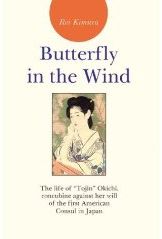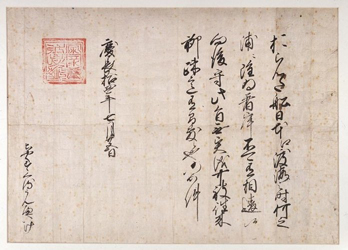What a horrible book.
Story.
Book.
Translation.
Erm… Let’s make my mind up!
 I was pretty curious about the life of Okichi Saito, concubine of Townsend Harris, the first American Consul to Japan in 1856. ‘Tojin Okichi‘ (‘tojin’ being the mistress of a foreigner) didn’t want to be his courtisane but the feudal system made her because it would provide better negotiation opportunities for the Japanese. It ruined her life – and of those around her. No, I am not giving anything away by saying that because it is common knowledge (early in the book) and even so, the author herself… No, I’ll get to that later ;)
I was pretty curious about the life of Okichi Saito, concubine of Townsend Harris, the first American Consul to Japan in 1856. ‘Tojin Okichi‘ (‘tojin’ being the mistress of a foreigner) didn’t want to be his courtisane but the feudal system made her because it would provide better negotiation opportunities for the Japanese. It ruined her life – and of those around her. No, I am not giving anything away by saying that because it is common knowledge (early in the book) and even so, the author herself… No, I’ll get to that later ;)
At first I just got annoyed by the awful translation. To make some of my Dutch readers cringe, I would like to present 3 short sentences (I couldn’t choose!). Non-Dutch readers will just have to accept that these quotes are really terrible ;)
Alleen door zichzelf zo te kastijden kon ze de pijn lenigen van een uitstoting die ze de rest van haar leven zou voelen. [p.47]
Het was een pand tussen een vriendelijke rij nameko-huizen, zo typisch voor Shimoda en zag uit op het drukke puin. [p.55]
Dan drukte zich de hel opdringende omgeving van haar noodlijdende kapperszaak haar op de werkelijkheid van wat er van haar geworden was en haar gezicht betrok. [p.68]
Hey, reading these translations I think I just discovered who is really behind the Google translator! LOL
 More and more I got the feeling I wouldn’t have liked the original either. The book is full of Okichi’s thoughts and feelings, almost more than anything else. I guess (and hope) author Rei Kimura studied a lot of Egodocuments in the Okichi Museum in Shimoda (there are no endnotes so I can’t be sure) but I still think she has filled in too much of what she can’t know. At one time she even lets the protagonist mourn that her friend Naoko was born in the wrong place and time for her ambitions. Of course it would be great if the author made us think that, but Okichi could not have known how much times would change, especially for women.
More and more I got the feeling I wouldn’t have liked the original either. The book is full of Okichi’s thoughts and feelings, almost more than anything else. I guess (and hope) author Rei Kimura studied a lot of Egodocuments in the Okichi Museum in Shimoda (there are no endnotes so I can’t be sure) but I still think she has filled in too much of what she can’t know. At one time she even lets the protagonist mourn that her friend Naoko was born in the wrong place and time for her ambitions. Of course it would be great if the author made us think that, but Okichi could not have known how much times would change, especially for women.
There’s just a small voice in the back of my head that keeps wondering… Before Butterfly in the Wind was printed, it was published digitally and nominated for the E-book Awards of the Frankfurter Buchmesse :\
But I also didn’t like how the story got ‘thrown together’. Way before the middle of the book the reader already knows how it will end. And then has to read about it again and again… First Kimura tells us what is going to happen next, then she decribes it in detail – only to look back on it again in the following pages. I got REALLY tired of it! I assumed I would still like to read her book about Aum Shinrikyo, the religious group that carried out the sarin gas attack in the Tokyo subways in 1995. That also seemed like an interesting topic. But now that I have finished Butterfly in the Wind… PLEASE don’t make me?!
I can’t recommend this book to anyone: it left me feeling completely miserable. Yes, Okichi Saito has had a very sad life. But this horrible book and translation don’t do her much credit.
 Having said that, I would like to tell you why it has been interesting reading Butterfly in the Wind at this moment. Before the Americans entered Japan in 1856 and Townsend Harris ‘negotiated’ the Treaty of Peace and Commerce, a.k.a. Harris Treaty,
Having said that, I would like to tell you why it has been interesting reading Butterfly in the Wind at this moment. Before the Americans entered Japan in 1856 and Townsend Harris ‘negotiated’ the Treaty of Peace and Commerce, a.k.a. Harris Treaty,  the Dutch were the only foreigners allowed to trade with (and live in) Japan for more than two centuries, starting in 1609. So this year we are celebrating 400 years of exchange between Japan and Holland! There’s even a special coin: Japan Fiver (valid currency worth 5 euros) — and I’ve got it ;) I will hang on to it for a while and then find an appropriate event to spend it.
the Dutch were the only foreigners allowed to trade with (and live in) Japan for more than two centuries, starting in 1609. So this year we are celebrating 400 years of exchange between Japan and Holland! There’s even a special coin: Japan Fiver (valid currency worth 5 euros) — and I’ve got it ;) I will hang on to it for a while and then find an appropriate event to spend it.
This weekend I will be visiting From here to Tokyo, an exhibition where the authentic 1609 trade permit from Shôgun Ieyasu Tokugawa on display; the document allowing the Dutch East India Company (VOC) monopoly of trade. I am looking forward to that more now that I have read Butterfly in the Wind! It brings Japanese history closer to today.

There’s also an online exhibition on this topic in Het Geheugen van Nederland; texts are in Dutch but you might just look at the many ancient pictures!
I have thought about getting rid of Butterfly in the Wind, but I think I will keep the book because of its photographs — and to look up places to visit when we may be planning a trip to Japan in the future… But first I am going to do some more ‘virtual’ traveling through books. I am not finishing the Japanese Literature Challenge with a disappointing read like this! Just wait and see :)



6 reacties
Comments feed for this article
zaterdag 12 september 2009 bij 04:36
Bellezza
What an interesting review you’ve written! I love how unabashedly you critique the work, and for the reasons you give, I doubt very much that I would like it either. I loathe reading a book’s ending over and over and over from when you’re only half way through it. It was interesting to hear of the coin, and the interaction that Japan had with Holland. I had no idea! So, I appreciate your very informative post.
maandag 14 september 2009 bij 19:23
tanabata
I hadn’t heard of Okichi Saito before and it must be an interesting story, it’s too bad that it was presented so poorly in this book.
I knew the Dutch had been allowed to trade with Japan in the old days but I didn’t realize it was exactly 400 years this year! The exhibition sounds wonderful.
dinsdag 5 januari 2010 bij 23:29
mefeather
*cringes when reading the Dutch sentences* They are horrible indeed. I think, the winner [of these three examples] of the most horrible one will go to number three. I almost couldn’t read the whole sentence as it was just SO horrific.
Love your review, because you explain very well what it is that troubles you with this book.
vrijdag 22 januari 2010 bij 11:23
inckley
Rei kimura has a beautiful story.I don’t hear the story before..the story can make me think about a hard life….
…I like Tsurumatsu spirit….^^
vrijdag 22 januari 2010 bij 11:56
inckley
Reii..you have an amazing story about Okichi…ican’t stop reading before end..^^
it’s really?? i think “tojin’Okichi has a very very hard life…
..you give me one message that i must be strong to walk in life which i cant immagine…
rei Kimura,, Gbu..^^
zondag 10 oktober 2010 bij 10:48
Coffee & Croissants in France (Progress Update Hour 20) « Graasland
[…] or In Cold Blood by Truman Capote, or the Marlene Dietrich biograhy by her daughte Maria Riva or Butterfly in the Wind by Rei Kimura… can go on […]